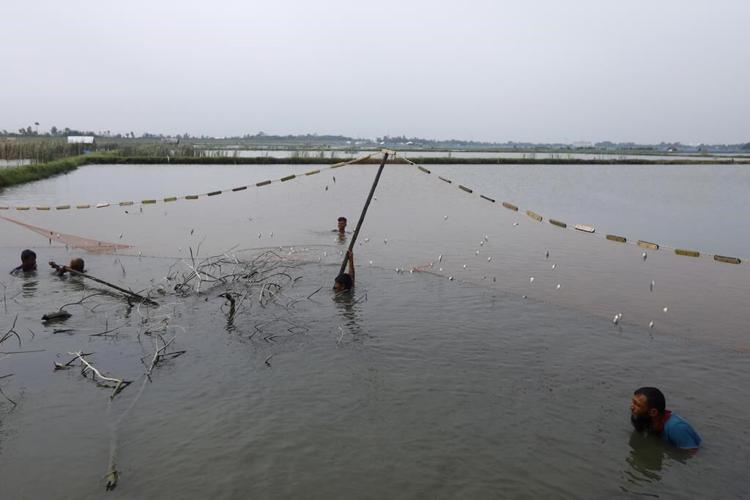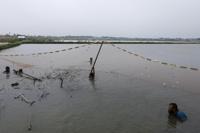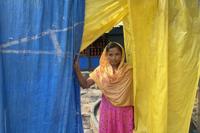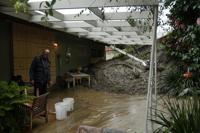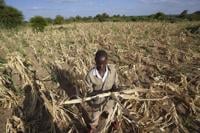RAMPAL, Bangladesh (AP) — Fish, rice, mangrove trees and the lush delta wetlands where the massive Ganges, Brahmaputra, and Meghna rivers drain into the Bay of Bengal.
It’s not luxury. But for the farmers and fishermen who live by the world’s largest mangrove forest, it’s more than enough. Now, the environment is at risk.
A power plant will start burning coal near the Sundarbans this year as part of Bangladesh’s plan to meet its energy needs and improve living standards, officials say. Home to 168 million people, Bangladesh is among the most densely populated countries in the world. Once the power plant begins functioning at its full capacity, it will generate 1,320 megawatts of power, as much as Bangladesh’s largest coal power plant generates now.
The developing world needs its people to live better. But fossil fuel-powered economic growth can create environmental problems and make lives worse.
Popularly called the Rampal coal power plant, the Maitree Super Thermal Power Project will burn some 4.7 million tons of coal annually, emitting about 15 million tons of carbon dioxide and other planet-warming gases. Plus, some 12,000 tons of coal will be shipped by boat through the Sundarbans each day, prompting fears of water pollution.
Low-lying Bangladesh is already hit by tropical cyclones and rising seas and millions are at risk of being displaced by flooding and other extreme weather. Just two weeks ago, 24 people died, 20,000 people were marooned, 10,000 people lost their homes and 15,000 acres of crops were destroyed by the .
“If it turns out bad, we will have to sell our properties and migrate,” farmer Luftar Rahman said.
Top scientists say there can be no new fossil fuel projects if the world is going to limit warming to the 1.5 degree Celsius (2.7 Fahrenheit) temperature goal set in the Paris Agreement. Even though it is among the lowest-emitting nations in the world, Bangladesh has pledged to reduce its overall emissions by 22% by 2030. The building of this coal spewing power plant is likely to hinder the nation's efforts to reduce its emissions.
But in October, around 80% of the country suffered a blackout for seven hours as a result of the country's power grid collapsing. Such blackouts and long power cuts, sometimes for as long as 10 hours a day, affect businesses including the garment industry, which accounts for 80% of exports. Bangladesh is the world’s second-largest garment exporter, after China.
“We are desperately waiting to start generating power at Rampal. This plant will definitely help ease our energy woes,”said Tawfiq-e-Elahi Chowdhury, an energy advisor to the Bangladesh Prime Minister.
Bangladesh wants poor nations to receive funds to help adapt to the devastating effects of a warmer world. Until May of this year, Bangladesh was the chair of the Climate Vulnerable Forum, a partnership of countries highly vulnerable to warming. With much of its land at or just below sea level, the country has already suffered heavy flooding and erratic rainfall. A estimated that Bangladesh could suffer $570 million in damage annually from climate change-related extreme weather events.
In June, Bangladesh stopped running diesel power plants because of rising fuel prices. Bangladesh has two active coal-powered plants, and some experts say another isn’t needed.
“We need to be investing in power transmission and distribution systems. That would be much more beneficial for the country at this moment,” said Khondaker Golam Moazzem of the Dhaka-based economic think-tank Centre for Policy Dialogue
The country also has cleaner resources at home.
“Bangladesh has huge potential for natural gas. Onshore and offshore exploration and production of gas resources can be a better option compared to coal,” said Dhaka-based economist and environmental activist Anu Mohammad.
And renewable energy already powers millions of Bangladeshi homes.
“Bangladesh has actually got one of the fastest growing solar home systems,” said Saleemul Huq, director of the Dhaka-based International Centre for Climate Change and Development. “Another option is offshore wind power. With the latest technologies available, it is conceivable that wind power generated in the Bay of Bengal can provide for the needs of not only Bangladesh but also for regions in neighbouring India as well as Myanmar.”
The Rampal coal mine will be funded by the governments of Bangladesh and India. The Sundarbans was chosen because of available water and navigation facilities, officials said. The coal for the power plant will come from India as well.
The Sundarbans, “beautiful forest” in Bengali, evolved over millennia out of the Indian subcontinent’s mighty rivers. The Ganga, Brahmaputra, and Meghna dump rich sediments that they collect over thousands of miles from the Himalayas to the Indian ocean.
“The mangrove forests are a natural barrier to the ill effects of climate change and if they are affected, then the 10 million people who live in this coastal delta region will also suffer,” Mohammad, the Dhaka-based economist and environmental activist, said. “There are many alternatives to power generation. But there is no alternative to the Sundarbans.”
Mangrove forests are more effective than terrestrial forests at sucking carbon dioxide out of the atmosphere.
“During my grandfather’s time, all the rice we needed was harvested from our land. There was enough rice and fish for everyone,” said 60-year-old Abul Kalam, who has lived his entire life in the Sundarbans. “If this power plant comes up, there will be no fish in our region. How can we grow crops when they dump toxic wastewater here?”
___
Climate data journalist Camille Fassett in Seattle contributed to this report.
___
Follow AP’s climate and environment coverage at
___
Associated Press climate and environmental coverage receives support from several private foundations. See more about AP’s climate initiative . The AP is solely responsible for all content.

